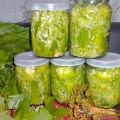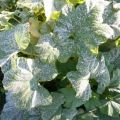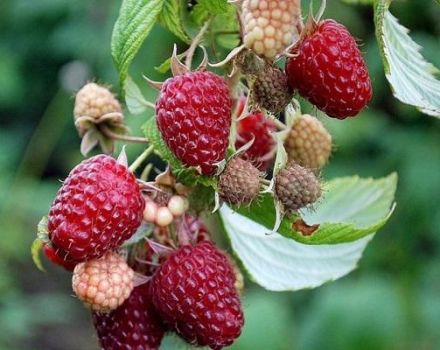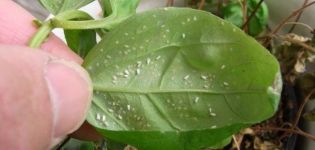A step-by-step recipe for pickling cucumbers in a village for the winter in jars
At any time of the year, you want to enjoy a delicious hodgepodge, pickle or vegetable salads. Therefore, harvesting juicy and crunchy country-style cucumbers for the winter should be a must. Cooking is not difficult and takes a little time. To make the result pleasantly pleasant, you need to strictly follow the recipe and culinary technology.
Secrets of pickling cucumbers in a village for the winter
There are several secrets, knowing which, you can easily prepare amazingly aromatic and crunchy pickles for the cold season.
For best results, it is advisable to use vegetables that grow in your own garden - in this case, you can be sure that they do not contain toxic substances. It is important that the cucumbers are not overgrown or overripe.
The characteristic pleasant crunch of pickles will be provided by oak leaves. They will also help preserve the product over time.
The taste and quality of cucumbers largely depend on the brine. For it, you need to prepare a bunch consisting of several fragrant cherry twigs, fresh horseradish leaves and dill stalks.
Required ingredients
To implement the traditional recipe for making delicious rustic cucumbers for the winter, you will need the following set of ingredients:
- fresh cucumbers (from 3 to 5 kilograms);
- sea or table salt;
- dill sprigs;
- oak, cherry, currant and horseradish leaves - to taste;
- a few cloves of garlic.

Product selection features
For this preparation, you need to select exceptionally beautiful, dense and strong medium-sized cucumbers with a uniform green color. It is also recommended to use smaller vegetables to fill the top of the container well.
Oak, cherry, horseradish and currant leaves used as additional ingredients must be free of the slightest signs of damage, with a uniform texture and color.
Preparation of containers
Glass containers for rolling, first of all, need to be washed in a water-soda solution. After that, sterilize by choosing one of the methods:
- Place the bottom upside down on a metal sieve on a saucepan. Boil for at least 15 minutes and then put on a cloth.
- Place the containers washed with water in the oven and heat it up to +160 ° С. Soak until the droplets are completely dry.
- Put the jars in the microwave oven, after pouring water to the bottom. The steam generated as it boils will sterilize them.
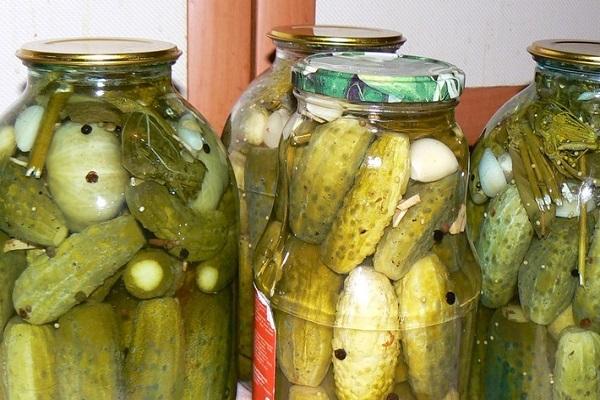
Cooking process
Following the proposed recipe, you can prepare such preservation even with minimal culinary skills:
- Rinse the selected cucumbers thoroughly and place them on a soft towel made of natural fabric to dry out.
- Rinse the greens, carefully cut them so that they let the juice out, and evenly place them on the bottom of a sterilized glass container.
- Then put the cucumbers themselves so that the large fruits are at the bottom of the container, and the small ones are at the top.
- Pour boiling water over for a couple of minutes and drain.
- Boil the aromatic and savory brine. To do this, throw a lush bunch of cherry leaves, dill and horseradish into boiling water. Add salt at the rate of 2 tablespoons per liter and granulated sugar - 1.5 tablespoons per liter. Boil for 15 minutes.
- Pour jars with slightly cooled brine.
It is not necessary to immediately roll up the lids, since the fruits should be thoroughly soaked within 2-3 days. Next, you need to shake the containers so that air bubbles rise up - they need to be removed with a clean wooden spoon. Then pour the rest of the brine evenly into the jars up to the very neck and close with sterilized reliable lids.
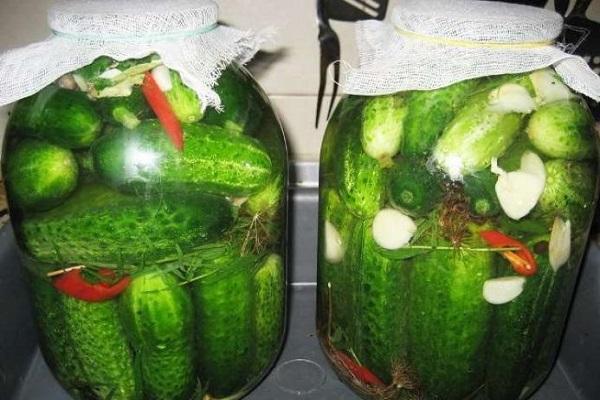
How and how much can be stored
There are several rules and recommendations for storing pickles in jars prepared according to a simple village recipe:
- The average shelf life of pickles is 8 months. However, this is possible only in conditions of temperature from -1 ° to +4 ° C and air humidity within 80-90%.
- It is not recommended to keep pickled cucumbers at temperatures above +10 ° C.
- Preserves that have not been heat treated are stored for one week at an air temperature of less than +17 degrees.
- The best storage places are a cellar or attic (in a private house), a balcony and a storage room (in an apartment).
- When storing conservation, do not allow the air temperature to rise, as this will lead to acidification of the solution and the growth of dangerous bacteria.





